Not many teams can claim the honour of holding first place in their league with a negative goal differential.
Up until their 3-2 loss over the weekend, Charleston Battery did.
The recent USL Championship Eastern Conference leaders (now 2nd) have had a bizarre season. Though most matches have seen them claim hard-fought, close wins, they’ve had a few head-scratchers in the mix as well, the two most prominent being a 7-0 loss to San Antonio and a 4-0 defeat at the hands of Indy 11. The loss against Indy is a perfect representation of those bizarre matches. Charleston’s longtime centre-back, Leland Archer, picked up a red card 12 seconds into the match for a last-man foul that set up a penalty kick goal for the visitors. Oddly enough, those two heavy defeats also came at home.
So what are we to make of the Charleston Battery? Are they USL championship contenders or pretenders? This tactical analysis will look at some of the underlying data from the 2023 campaign and then offer a scout report of manager Ben Pirmann’s tactics to gauge the qualities that will help or hinder Charleston’s chances,
Looking at the numbers
For anyone unfamiliar with the Charleston Battery, the team was founded in 1993 and has a number of notable alumni. Terry Phelan, who also played for Manchester City, Chelsea and Everton, represented the Black and Yellow for four seasons. Chris Ramsey, who worked as the Head of Player Development at Tottenham Hotspur and replaced Harry Redknapp on the QPR bench during the 2014/15 EPL season managed the Battery from 2001 to 2004. It’s a club with a brief history, but an impressive one considering North American soccer legends Eric Wynalda and Mark Watson also signed with the club during their playing careers. Not bad for a second-division side.
Despite some impressive names that have come through the club, they haven’t claimed a league title since 2012. Last season, they finished 12th out of 14 in the Eastern division and 25th overall, failing to qualify for the playoffs.
But this season brings renewed hope to the beautiful coastal city of Charleston. Through 17 matches, they’ve already recorded three more points than all of last season. Pirmann, the USL Championship Coach of the Year in 2022 while managing Memphis 901, has drastically improved the squad. With 28 points in 17 matches, Charleston is overperforming their 22.2 expected points. That said, they have found a way to grind out results in close matches. Of their eight wins, six were decided by one goal. Their four draws are equally split between 0-0 and 1-1 results. This is a team that’s developing a battle-harden mentality and fighting through tense moments in matches.
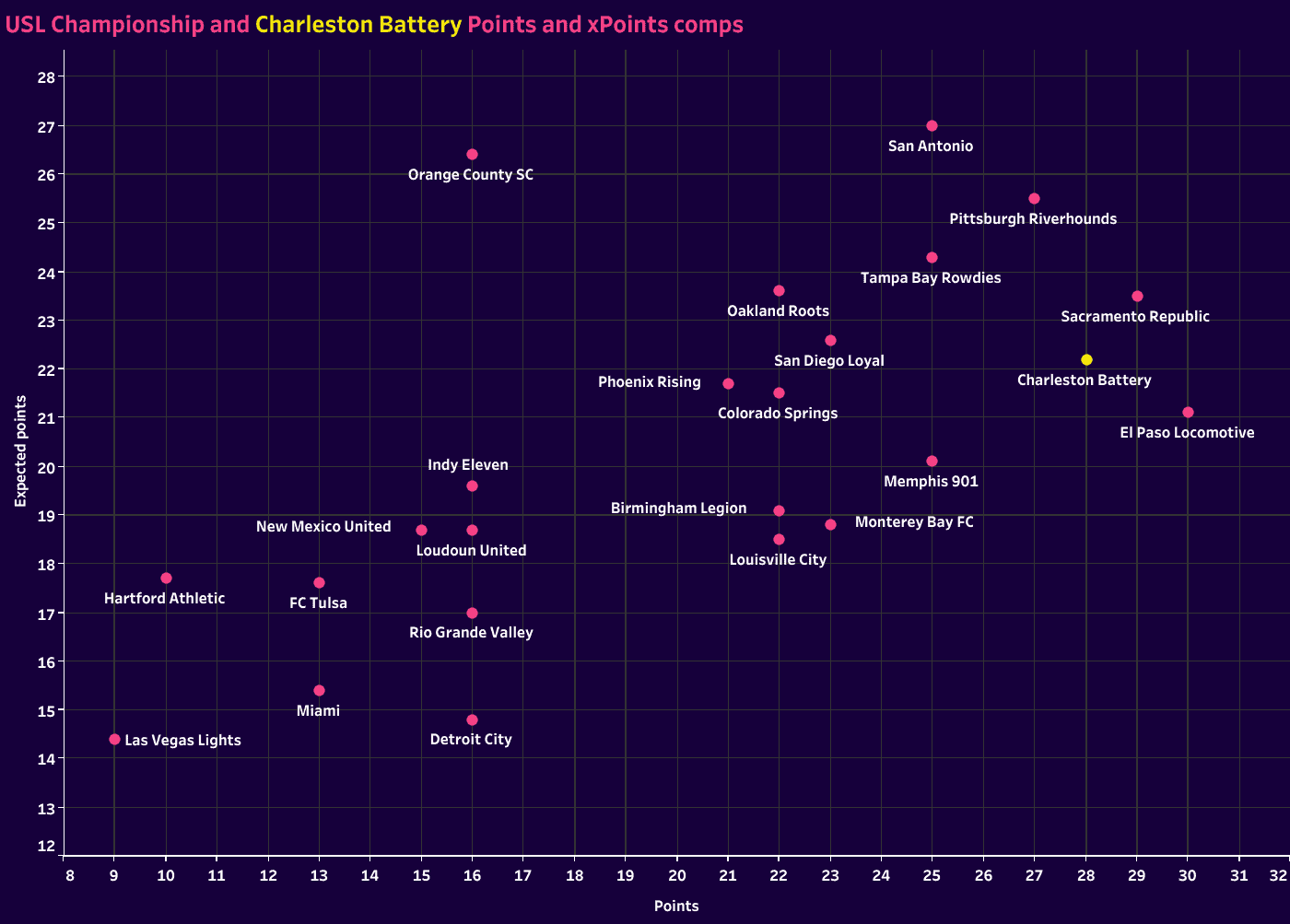
Looking at their goal-scoring and goals against, they currently sit with 23 and 27 respectively. Keeping in mind the 11 total goals conceded to San Antonio and Indy 11, the remaining 15 matches have seen the Battery put together 23 goals to 16 conceded, a much better tally and one more closely aligned with a table-topping team.
Turning to xG and xGA, that seventh-rated expected points tally starts to make more sense. Charleston is perfectly average for the league in both xG and xGA. There is the positive in overperforming xG, but that’s coupled with the negative of an even greater underperformance in xGA.
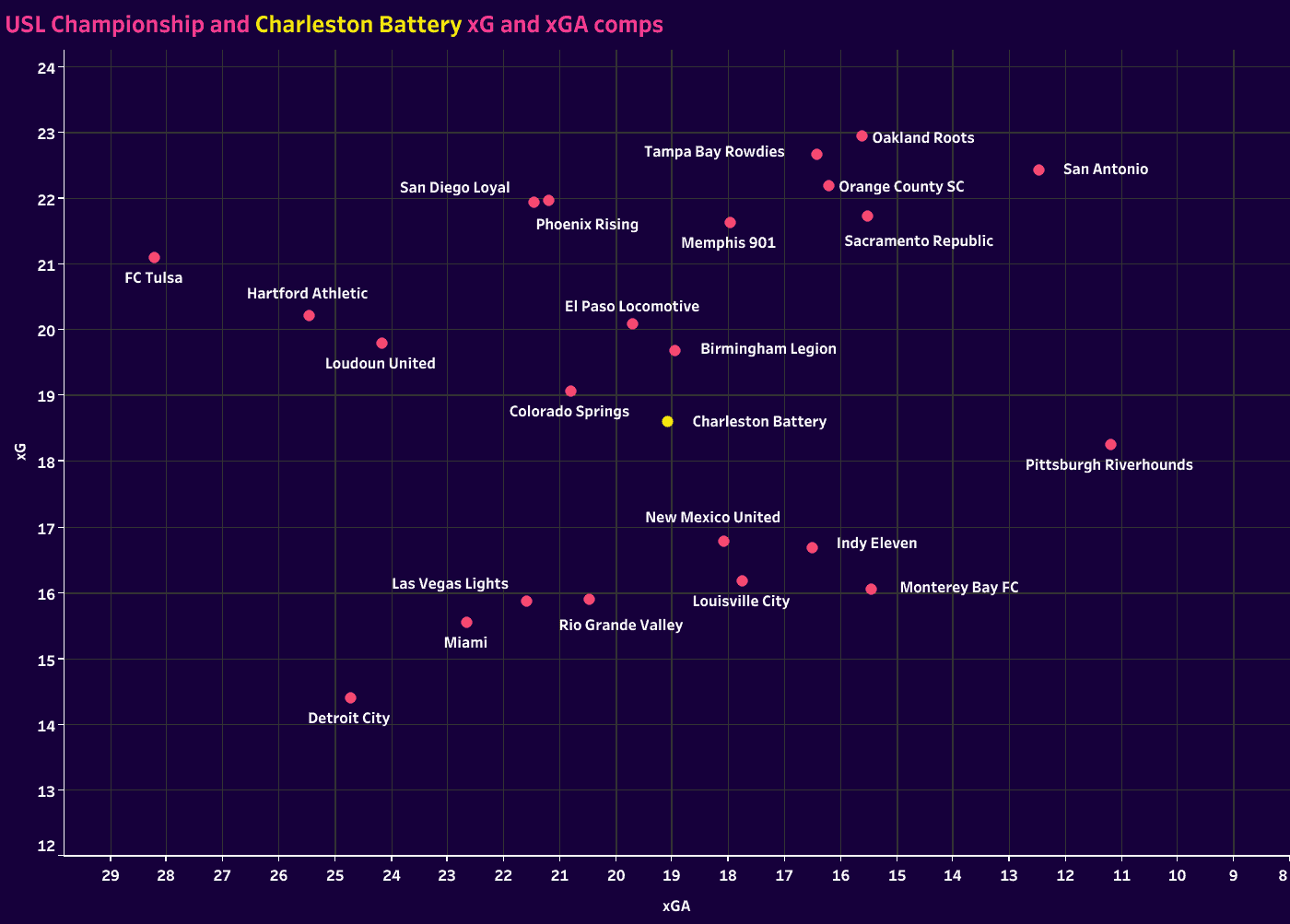
With an idea of the results and the goals, the last graph will look at in this section is Charleston’s possession and PPDA relative to the rest of the league. That will give us a nice springboard into our tactical analysis.
The Battery is the second most aggressive counterpressing in the league with a PPDA of 8.52. That’s coupled with the sixth-highest possession percentage at 53.2%. Pirmann has built a side that likes to have the ball, though not fanatically, and shows a very aggressive mentality to get it back once lost.
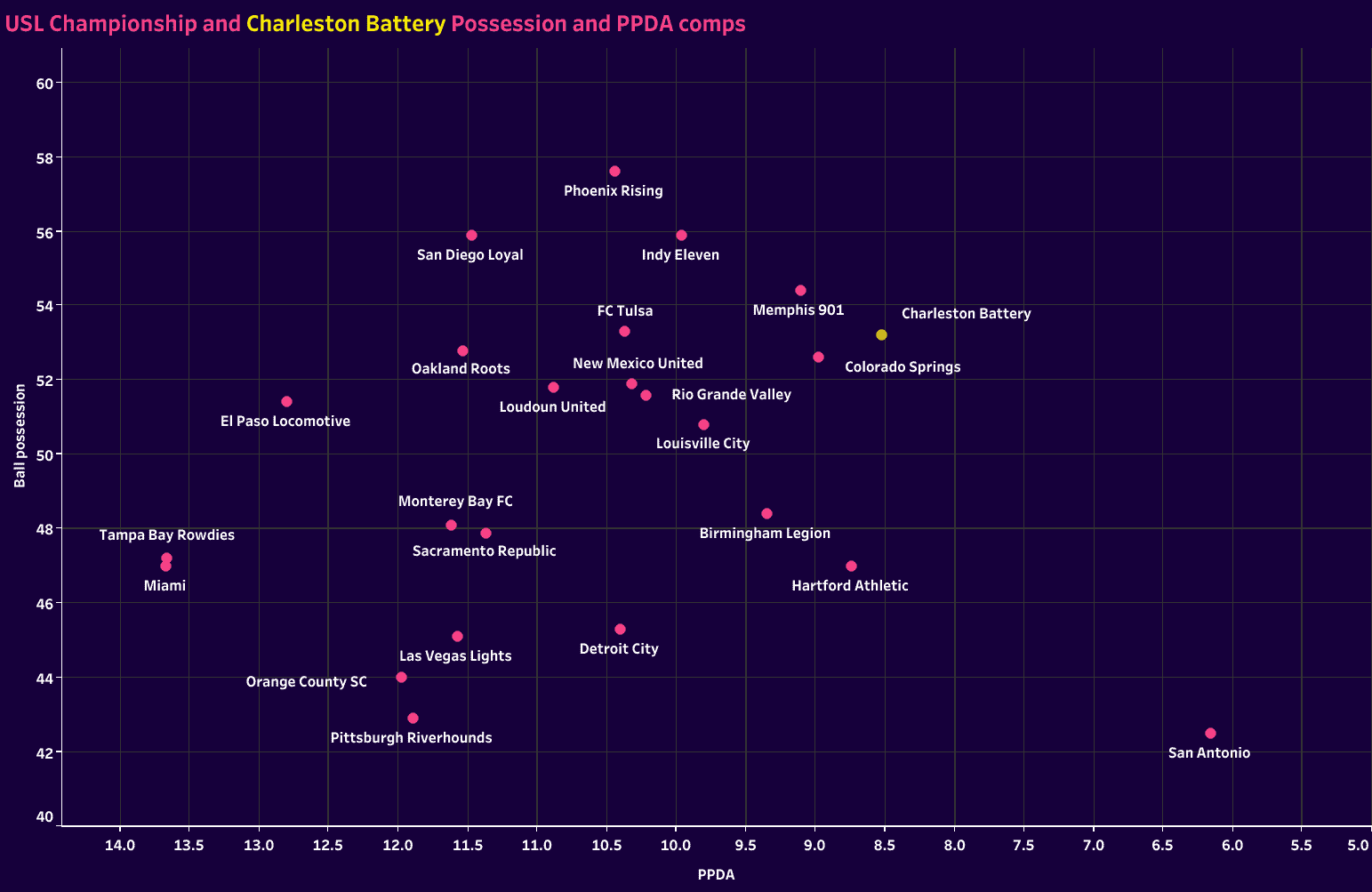
With some of the stats offering insights into Charleston’s season, let’s get to the crux of the matter. Is this Charleston Battery side a title contender or a pretender? More to the point, what are the tactics that can lead them to glory and what are the causes of concern as they head into the second half of the season?
The reasons Charleston will contend for the title
Success leaves clues, at least that’s how the saying goes. You don’t top the table at the midway point of the season without doing a lot of things well. Even despite Charleston’s negative goal differential, their defensive record looks significantly better when you take away the 7-0 and 4-0 losses. Right away, that raises their goal differential to a +7.
Within their 4-2-3-1 tactics, the double pivot gives them excellent protection in defensive transitions and their outside-backs are very selective as to when they move forward. It’s a recipe that has helped them to a good overall defensive record this season, save those two games of course.
Consistency on the defensive side of things, which includes avoiding slow starts and catastrophic mistakes at the back will go a long way in guaranteeing their success, but it’s the progress they’re making in attack that needs to get them over the hump.
Looking at their season heat map, there are four areas that light up brightly. We have that deep part of the left half-space, typically occupied by the left-centre-back, the left-wing, high in the right half space, and then scattered flashes in the right-wing.
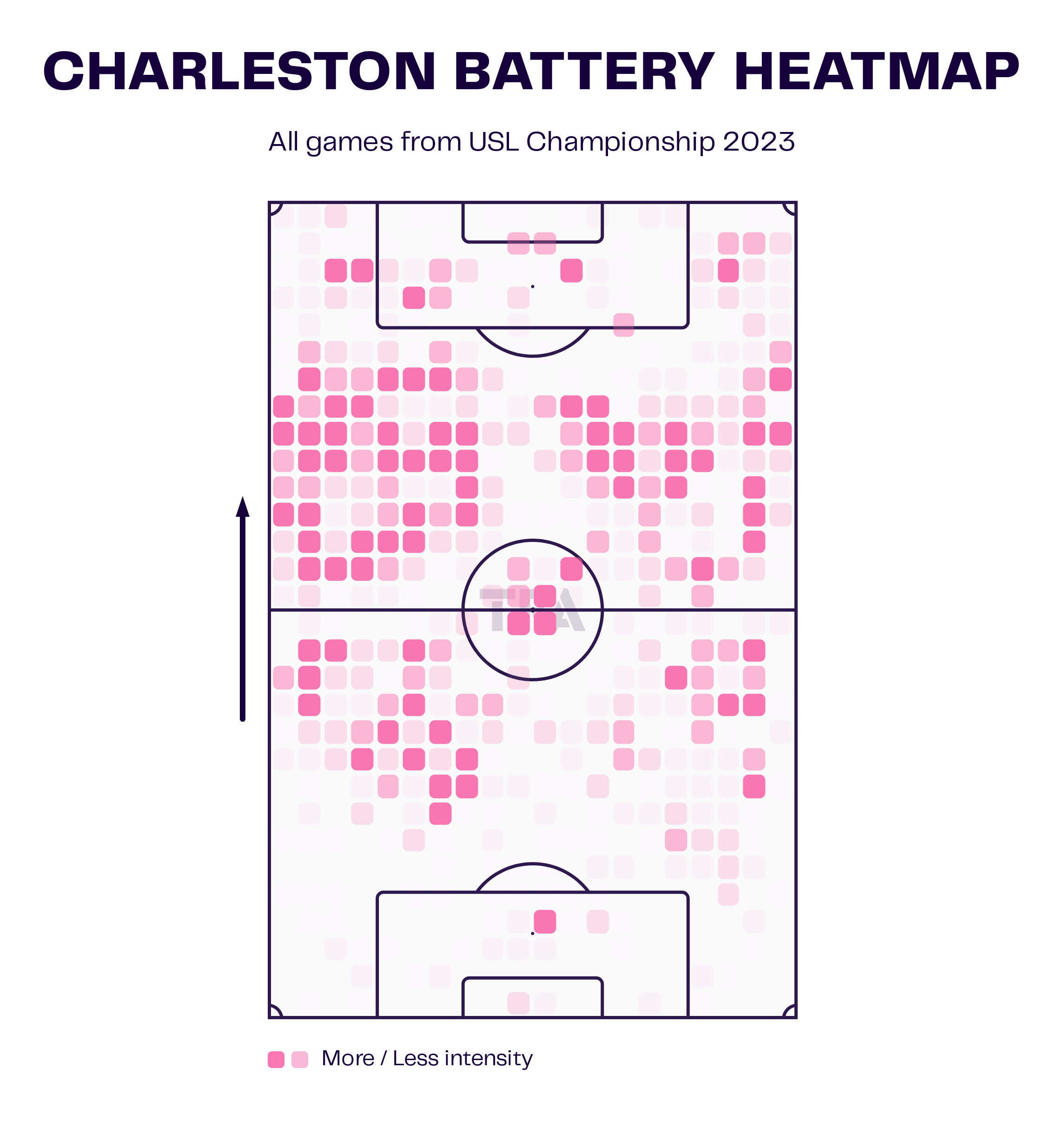
Combined with their ball progression map, you see the significance of wing play in this Charleston Battery team. On the left-hand side, there’s more activity and the means of progression is typically overloads in the wing and the half-space. That picture changes on the right-hand side. It’s often the right-back, Derek Dodson, who searches for optimistic moments to push forward and receive long switches of play while the right-forward, often Nick Markanich or 17-year-old Fidel Barajas, pushes into the half-space.
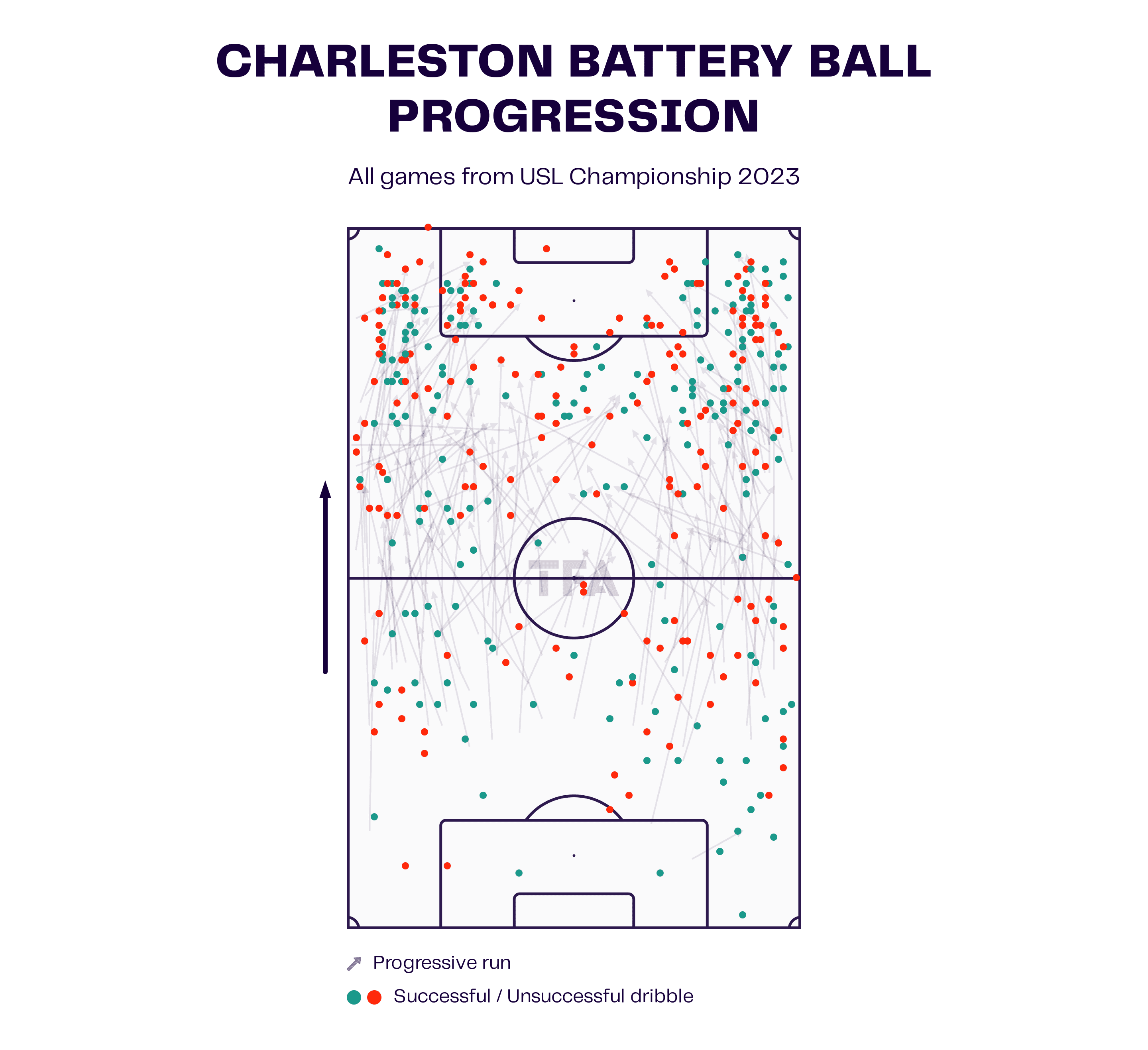
In fact, it’s typically the big switch of play from the left to the right that Charleston uses to play over the opponent’s press. The right forwards do really well to occupy multiple defenders and take interior positions to make the opponent’s defensive shape more compact. That frees up the wing for Dodson.
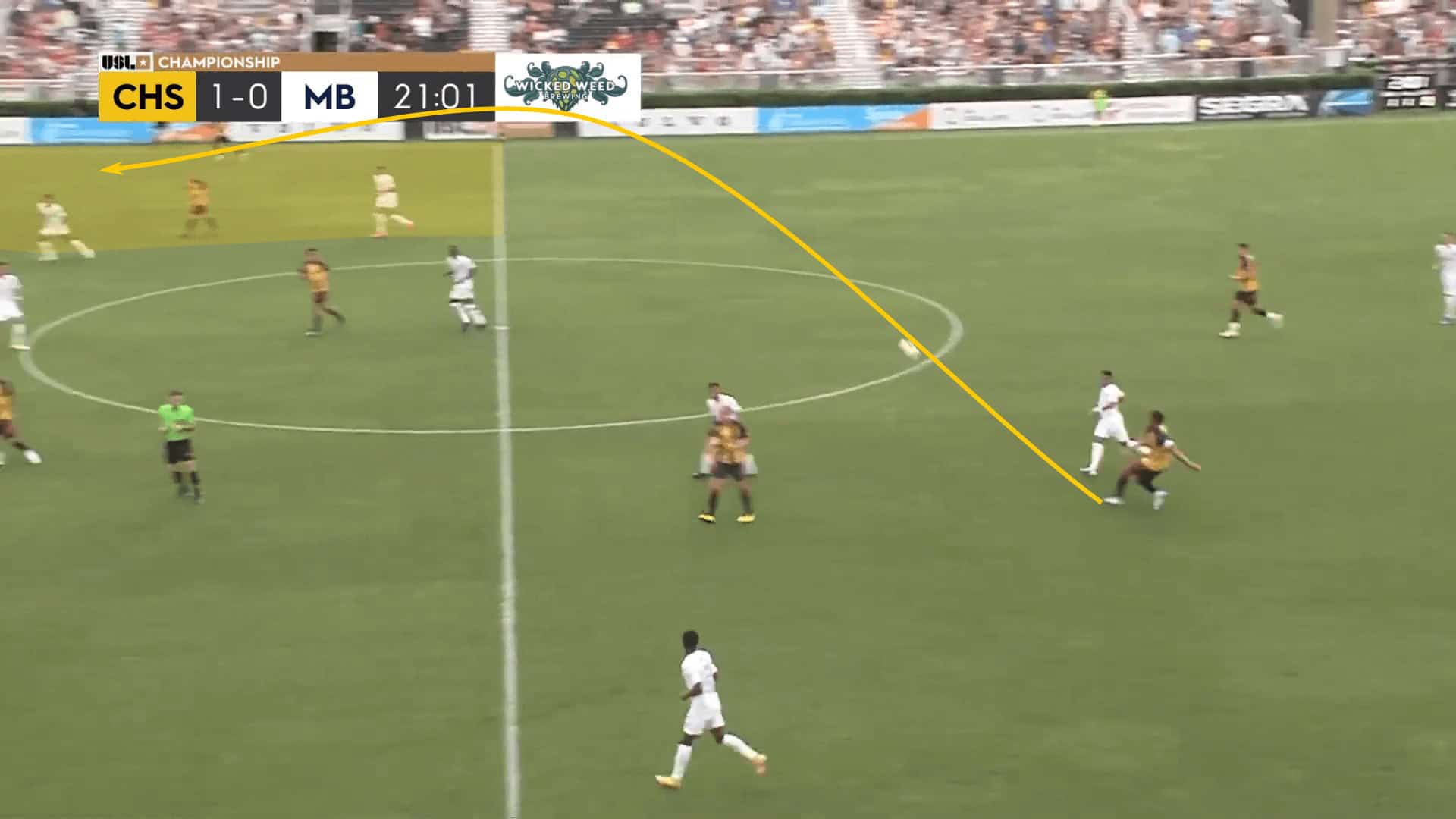
Whether the switch is coming from the left centre-back’s long diagonal or higher up the pitch through the left-sided attackers, getting Dodson on the ball high up the pitch is a clear priority for Pirmann’s side. In the example below, it is the switch that traverses the full width of the pitch that gets the right-back into the final third. He’s all alone and has timed his run to perfection.
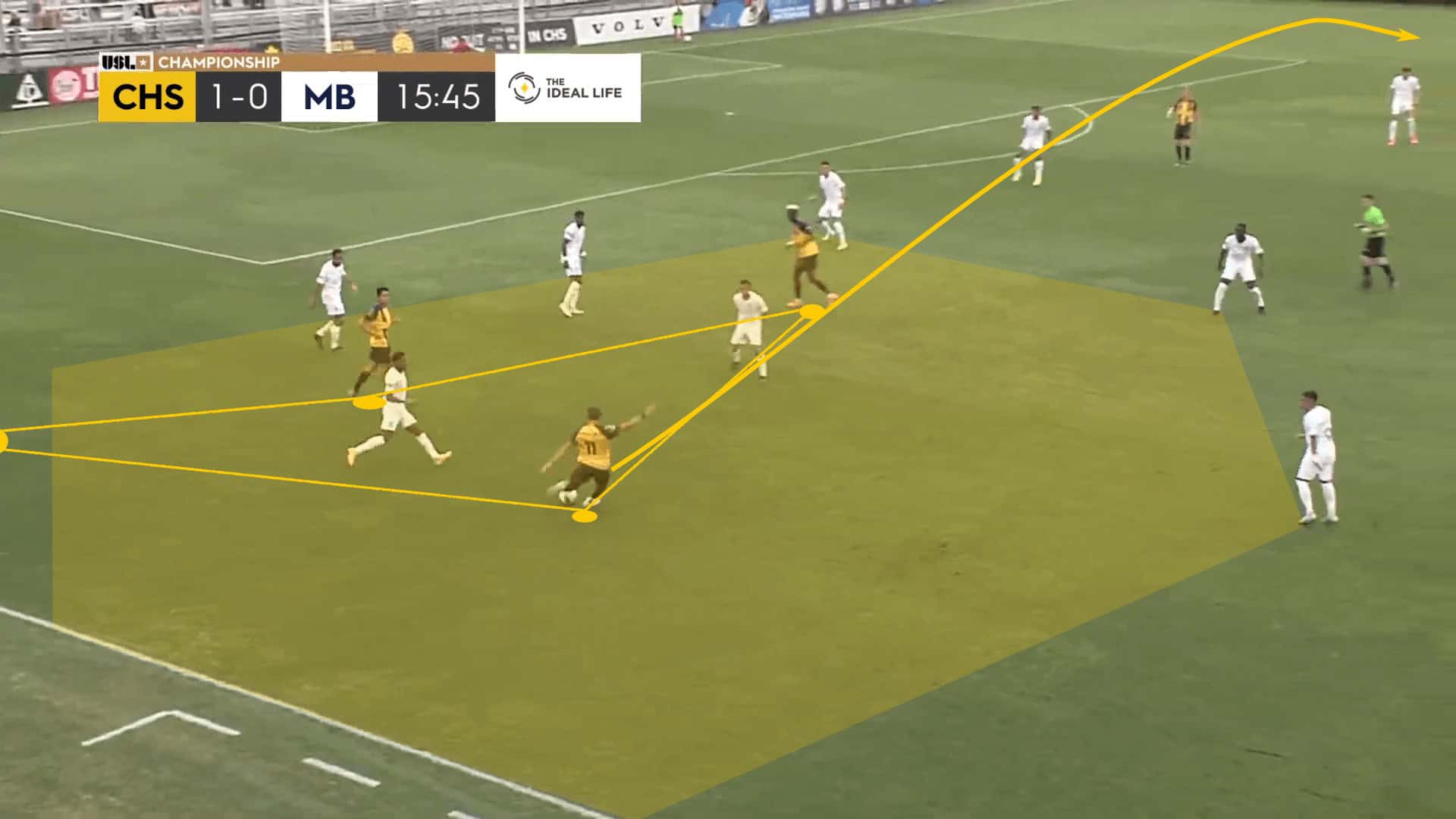
Once he has the ball in the wing, it’s common for one player to slide his direction into a support position, typically behind Dodson to clear defenders out of cover positions. Once the 1v1 is established with space behind the first defender, Dodson looks to engage on the dribble and put services into the box.
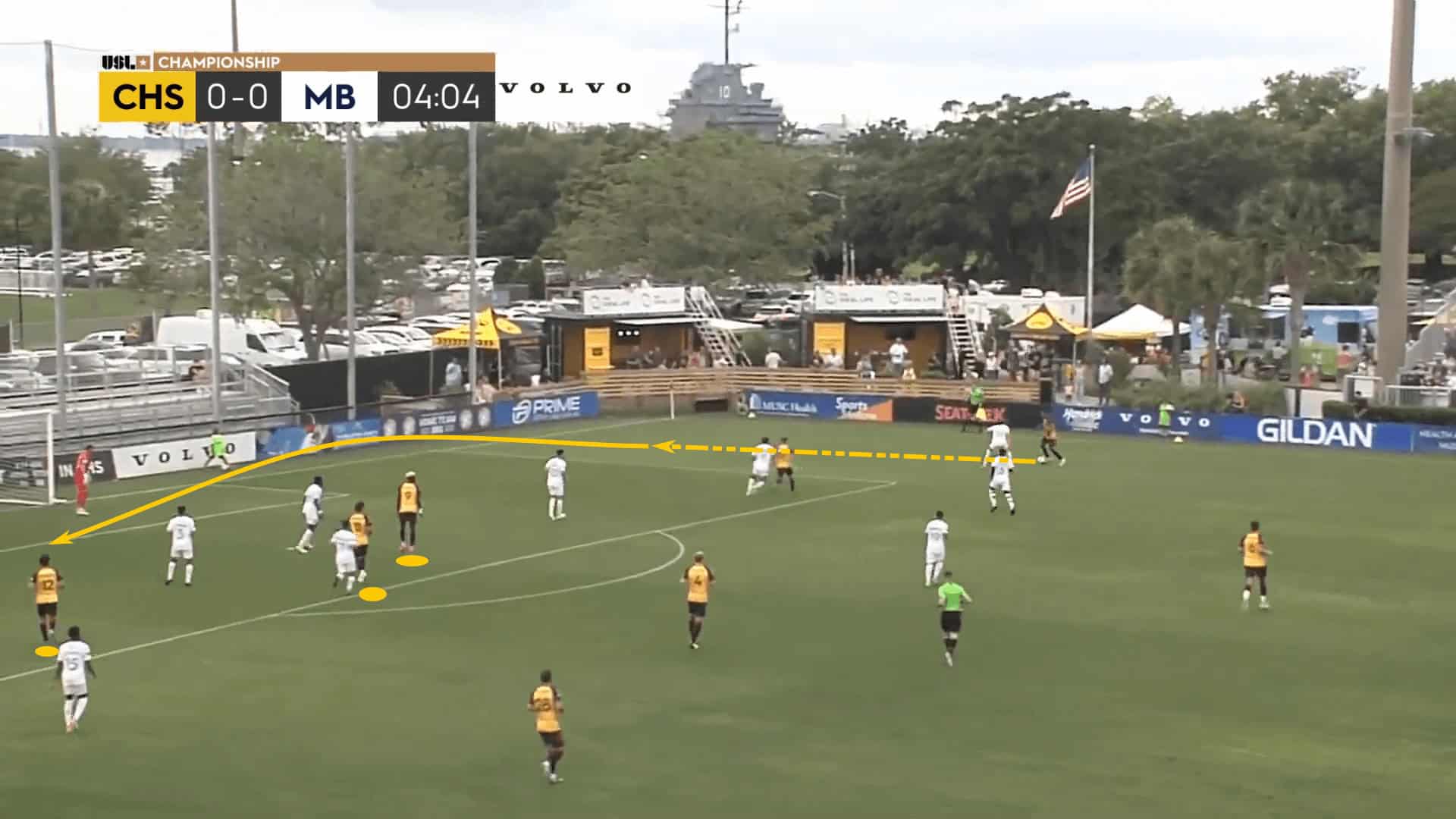
Looking specifically at Charleston’s crossing, the deliveries from the left tend to come from more interior areas whereas Dodson’s are often delivered from the wing. He’s not so much looking to turn the corner on the defender as he is looking to create enough space to send the dangerous service into the box. Half a yard is all he needs.
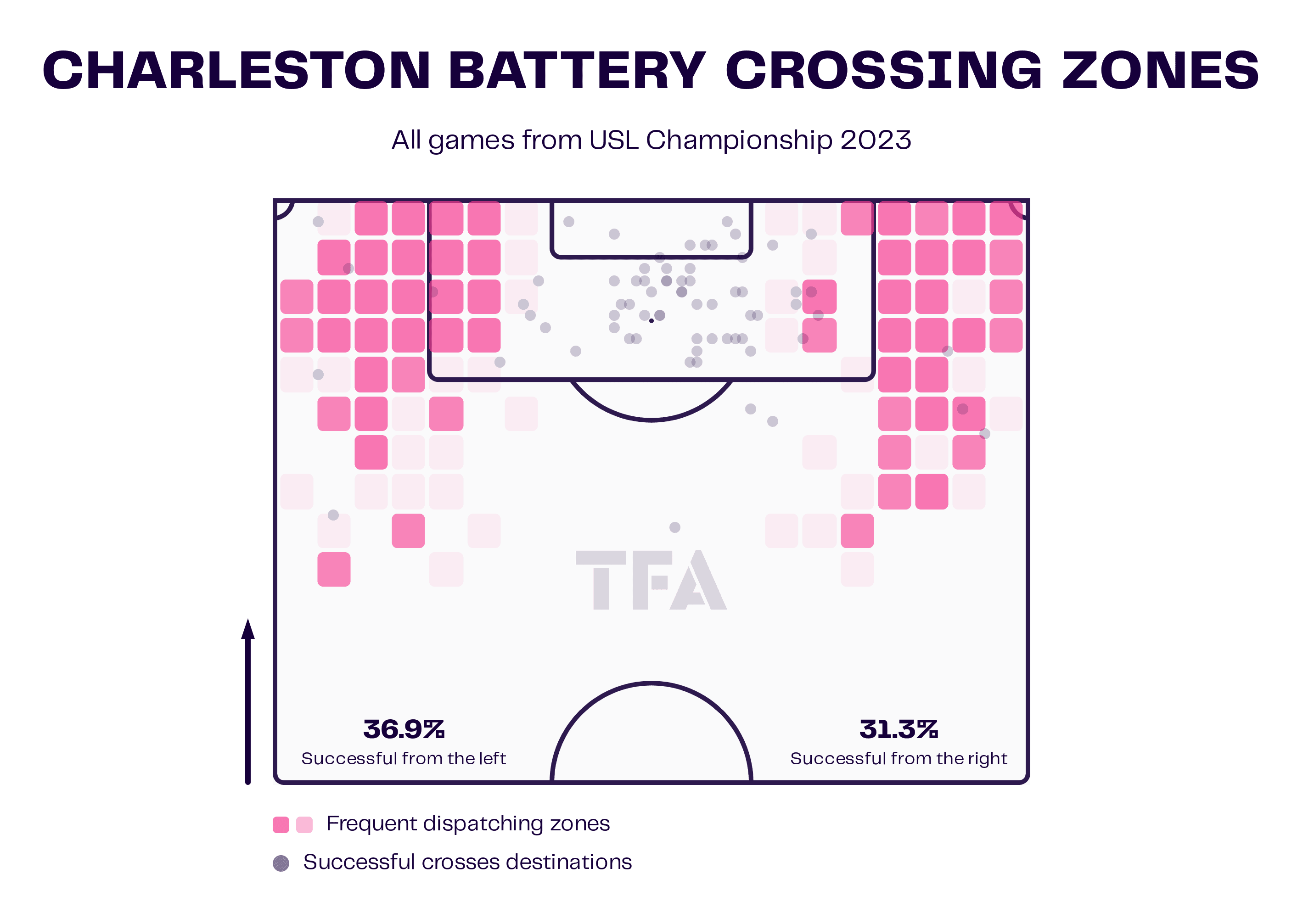
Especially when the ball is on the right at Dotson’s feet, Charleston is very good at getting numbers into the box. A high central overload gives them numbers to meet the cross or, if they choose to play into the overload, attack the opposition’s backline with combination play and runs in behind. That’s exactly what we saw against Monterey Bay. 3v2 centrally led to a simple pass behind the backline and a finish into the far post side netting.
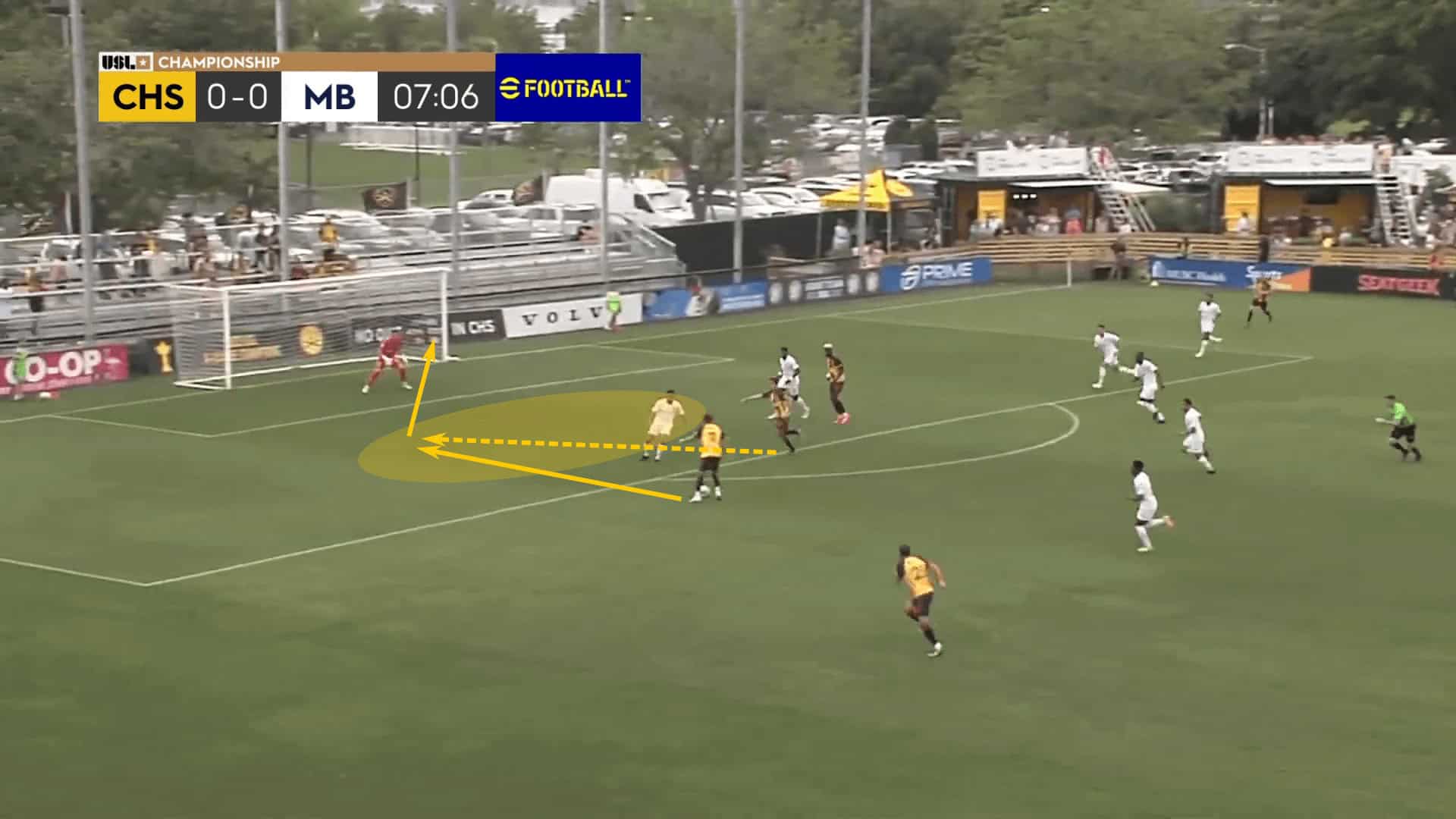
They’ve consistently outshot opponents this season, so it is just a matter of putting the ball in the back of the net. That has been an issue at times for Charleston, but the positive is that the opportunities are there. To keep themselves in contention for the title, they’ll have to be more clinical in front of goal.
The reasons Charleston will fade down the stretch
Goal-scoring could be an issue. While they do take a high number of shots per game, they do have a tendency to settle for lower-quality opportunities, resulting in that middling xG. Consistency in the opposition’s end is first and foremost but it’s not the only concern.
Compared to the rest of the league, Charleston rates third from the bottom in touches in the penalty area P90 minutes with just 12.01 and has the fifth worst xG per shot rating at 0.107.
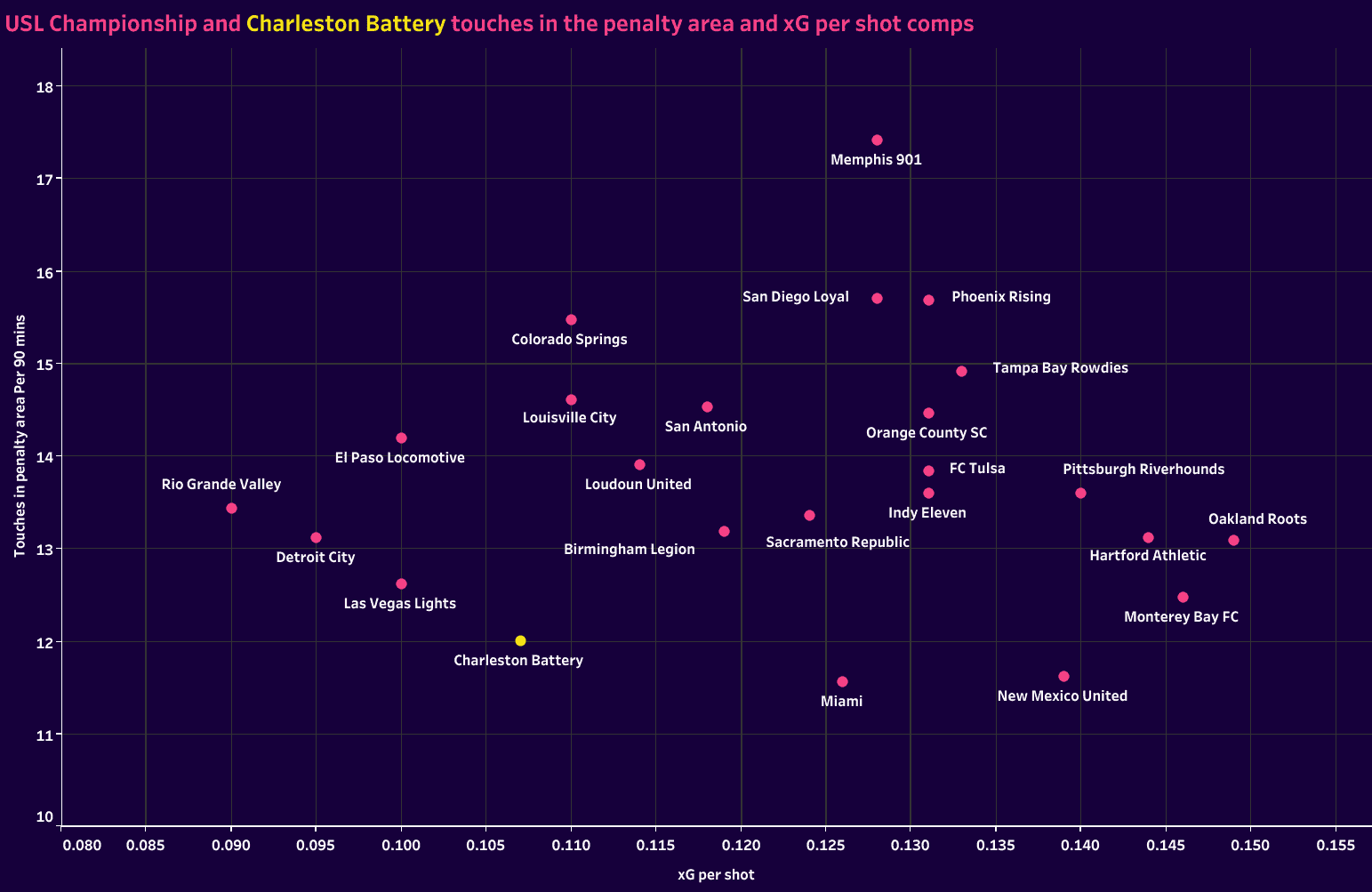
They’re taking enough shots per game, but the quality of the shots simply isn’t there. The graph below is a little bit dated as they have now scored 23 goals in 17 games, but it does shed light on a troublesome trend. The bigger point is the poor shot selection. Not only are they shooting from lesser quality locations, but the shots themselves need to be more clinical.
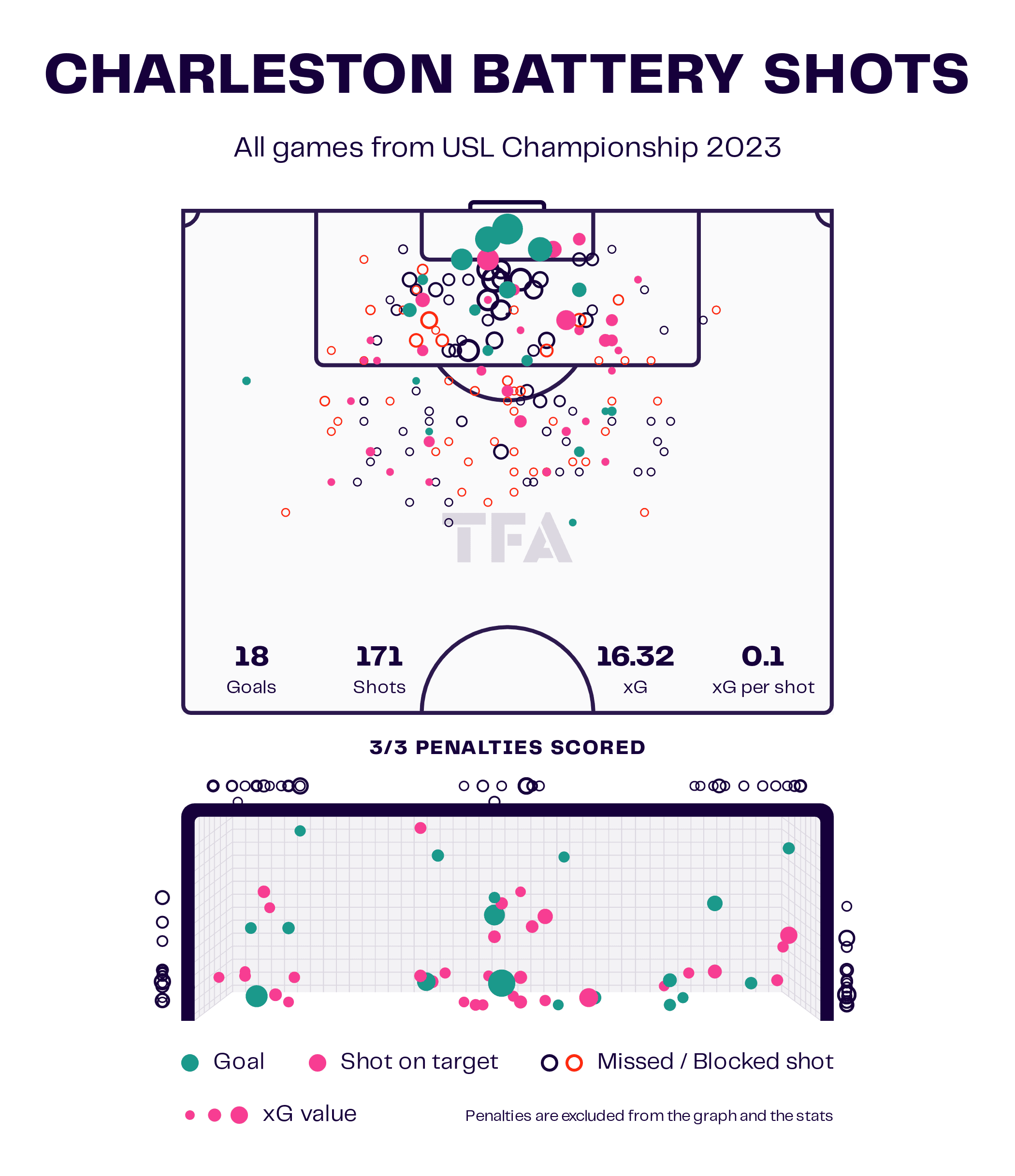
A couple of the more troublesome issues in recent matches have been the ability to defend set pieces and crosses. Not only are they getting beat on the first ball rather consistently, but even when they do win the first ball they often lose the second ball in a dangerous area. In the split-second it takes to shift focus from the first ball to the second, marking assignments are getting missed.
In these 7-0 shellacking against San Antonio, The first two goals highlight these issues. On the first one, it’s an early cross into the box. Charleston looks well prepared to deal with it with six players prepared to defend the delivery.
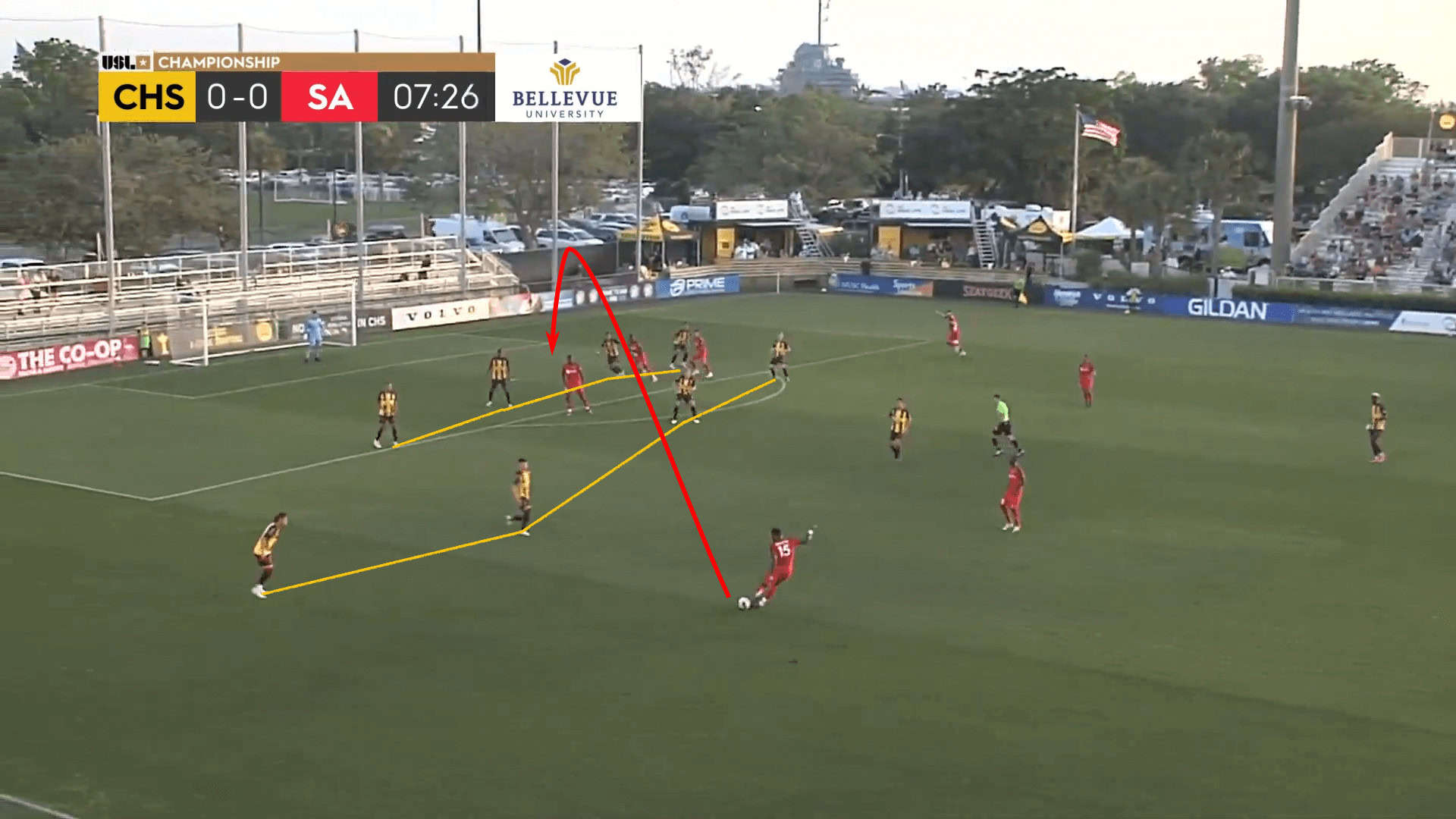
Charleston won the first ball but put it straight up in the air just outside of the six. The goalkeeper, Trey Muse, went up to punch the ball clear of danger but was beaten to it by San Antonio’s Niko Hansen. The ball bounced twice in the box before Samuel Adeniran supplied the half-volley finish from close range.
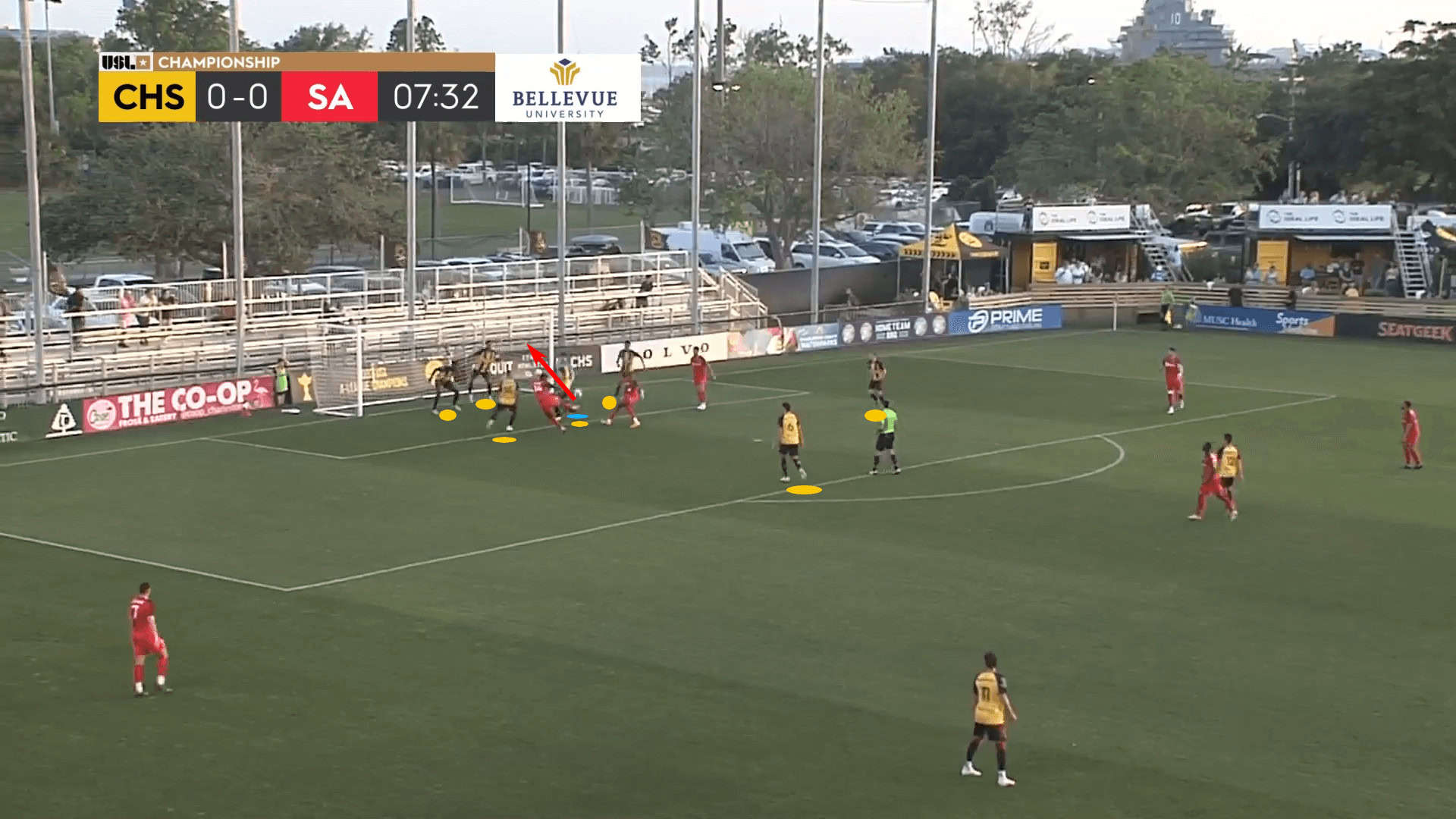
Look at the number of players Charleston has in the box to defend the cross. Eight players are there, yet the second ball is lost, the ball bounces twice and then an opponent virtually stands around waiting for the ball to arrive at his feet before finishing. The lack of organisation, awareness and intensity in defending the box hurt them badly.
And that wasn’t a one-off either. About 12 minutes later, San Antonio won the first ball off of an attacking corner kick. The shot was stopped at the near post, bouncing off the defender’s chest and into the goal mouth. In the image below, we see the amount of space afforded to the goal scorer, Fabien Garcia, as he won an uncontested header and hammered it past the goal-line defenders. Far too easy for the visitors.
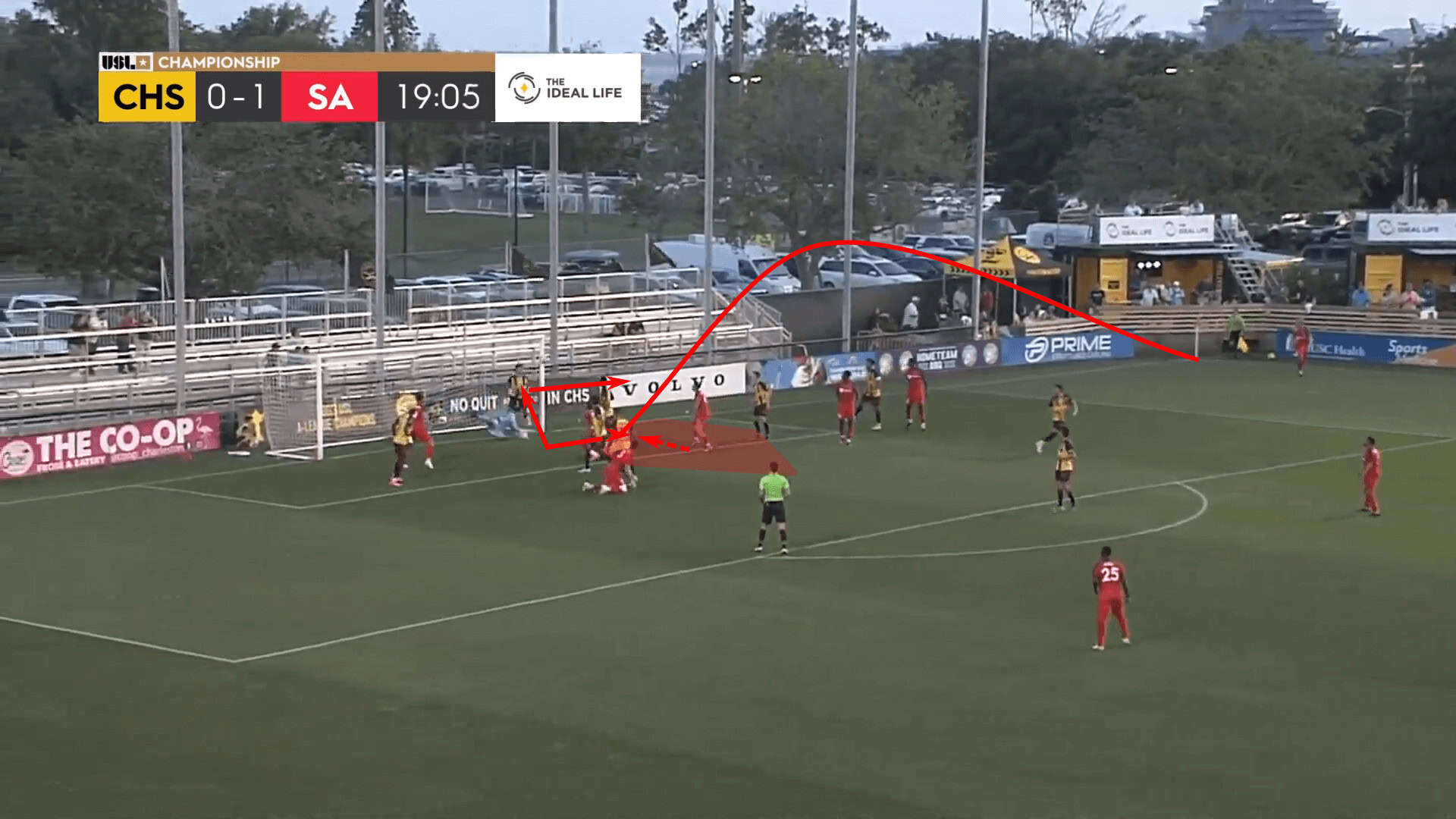
Those two sequences came from open play and set pieces. Against the Pittsburgh Riverhounds, an opening goal 21 seconds into the game immediately put Charleston against the wall. Disorganisation led to Charleston’s inability to defend against Pittsburgh’s aggressive, direct movement. Dodson kept the through ball onside and his teammates failed to track runners into the box. Two Pittsburgh runners are free at the top of the box and the finish was a simple one off of a negative cross from the penalty spot.
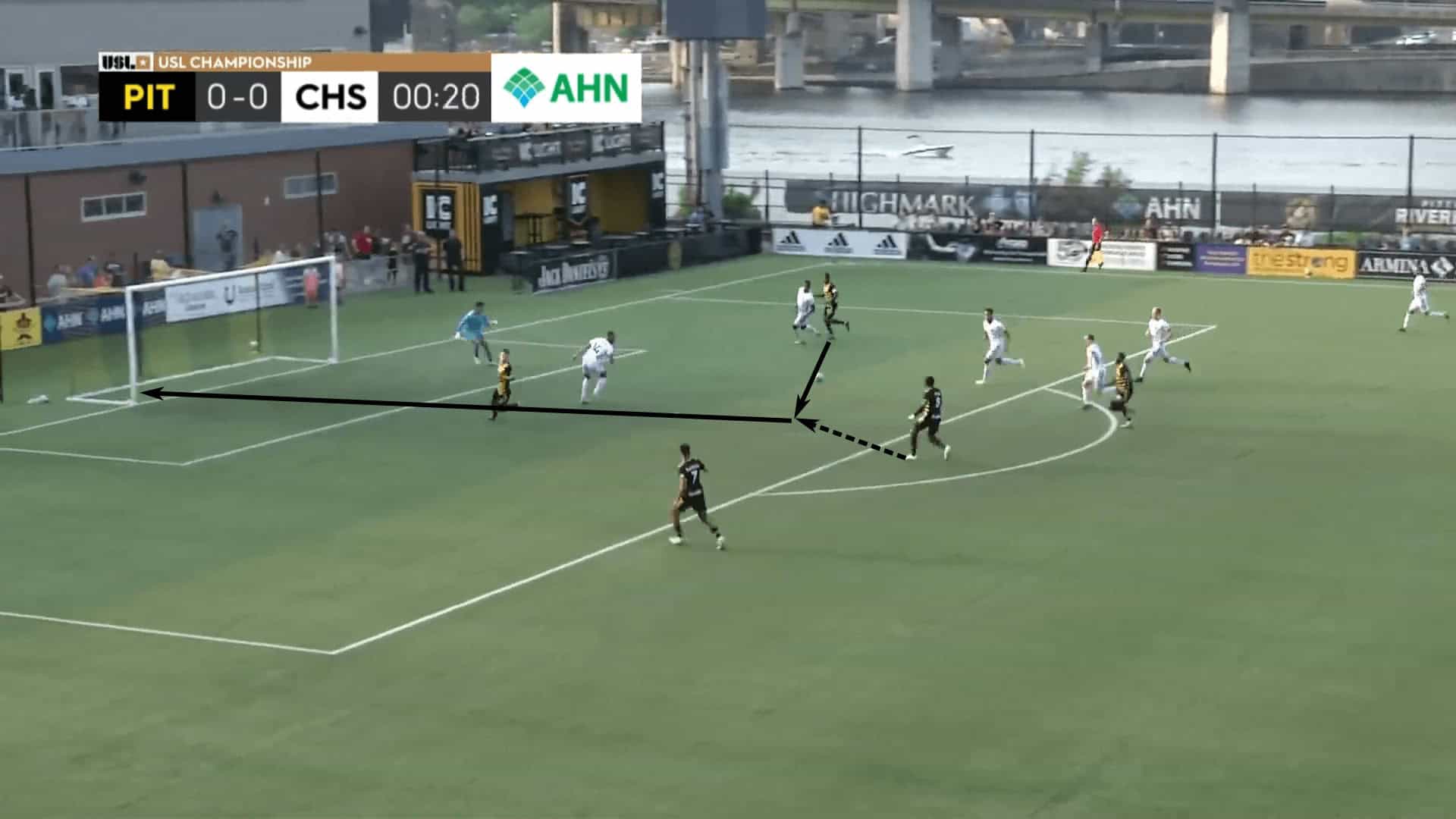
Defensively, there are some issues to sort out when defending in the box. Tracking runners has been a major issue in recent weeks. If it continues, Charleston will inevitably drop points and stumble through the second half of the season.
Conclusion
Pittsburgh has hit a bit of a rough patch recently, but the quality is certainly there to capitalise on early points gained. Matches like the 7-0 and 4-0 losses must be short-lived in the player’s memories.
This is a side that does a lot of things well, but you could argue there’s an equal number of things that they’re really struggling with at the moment. Defending crosses, both in open play and set pieces, is at the top of the list. It’s not only the first ball but also giving away quality opportunities to goal with the second ball.
This season already has a degree of success to it and the side has bettered last year’s point total. Rather than occupying the basement, we’re talking about a potential title run. There are lots of positives for Charleston but they surely won’t settle for moral victories. A high playoff seed and a run at the title are within their grasp. Some changes are needed to reverse the negative momentum that is building up. If made, Charleston can reclaim their momentum and push forward in their USL championship aspirations.





Comments